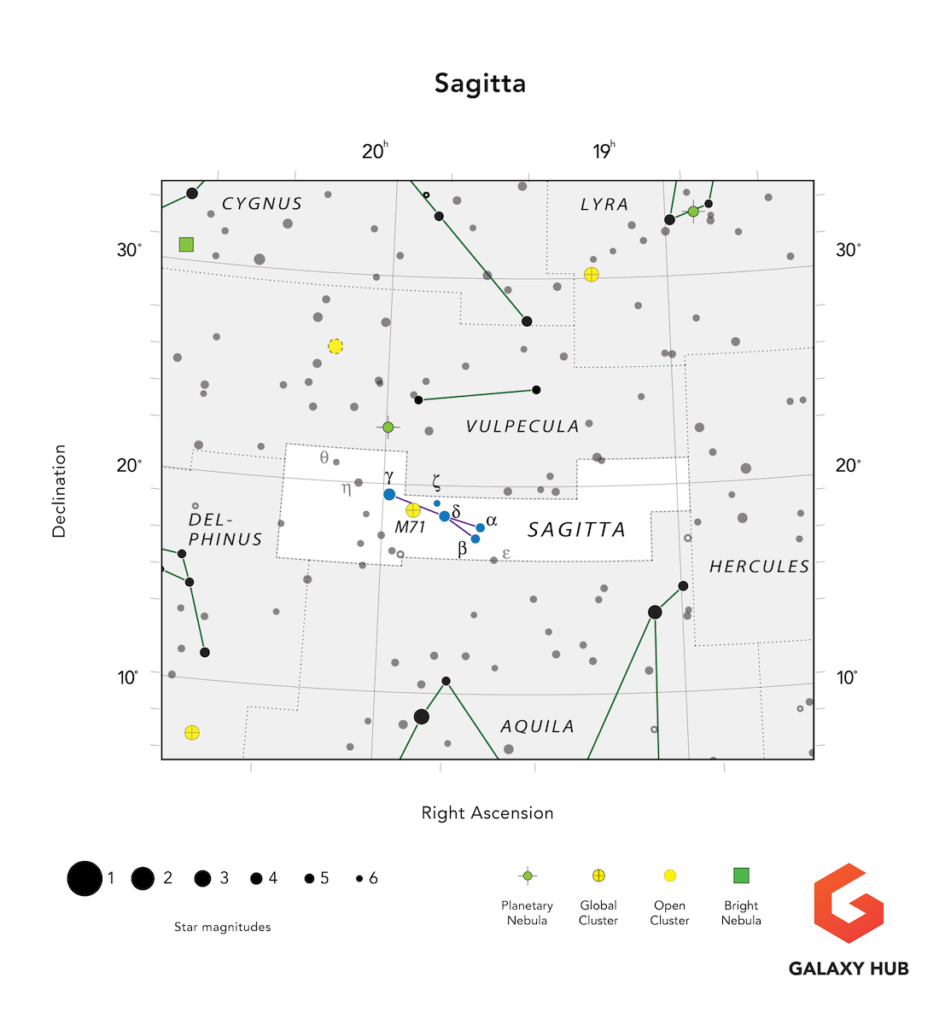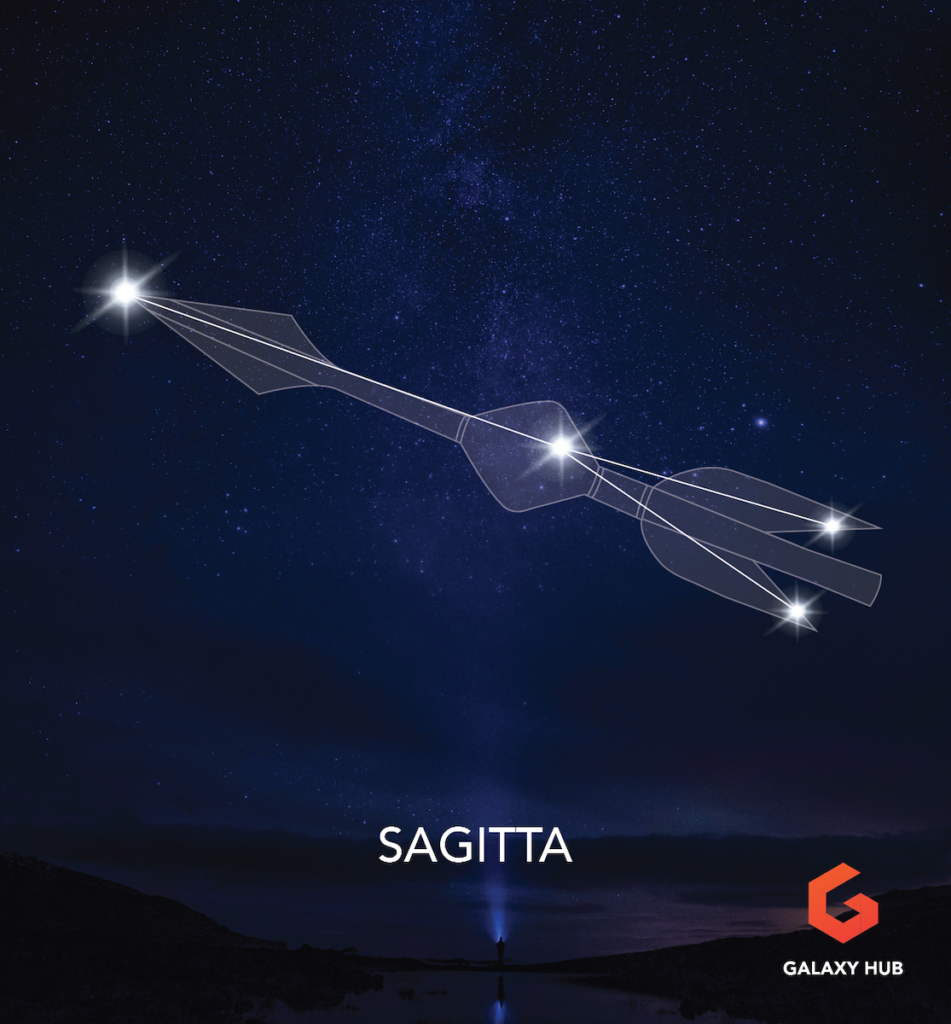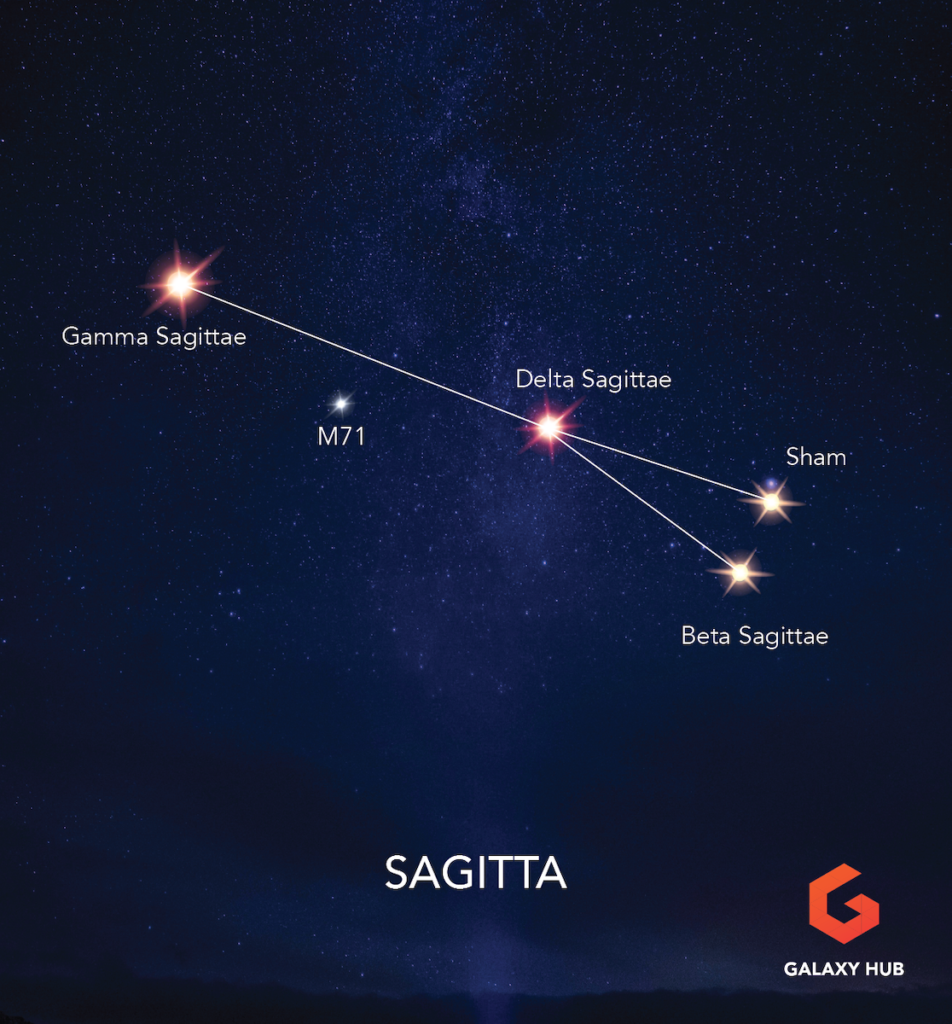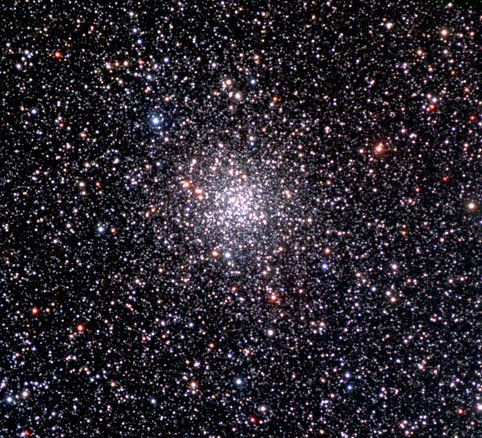Sagitta is a tiny and dim northern constellation, but it contains a number of exciting objects that make it a worthy target for observation. The band of the Milky Way that includes the Great Rift passes through Sagitta, and the constellation is also known for its one Messier object (a loose globular cluster), two notable planetary nebulae, and a number of rare or high-profile variable stars, which make it very popular with amateur astronomers.
The variable stars within Sagitta’s borders range from classic Cepheid variables to a rare RV Tauri class variable, several cataclysmic variables (one of which is expected to become the brightest star in the Milky Way when it goes nova in the somewhat near future), and a foreboding black widow star – a millisecond pulsar that is slowly destroying its companion.
Sagitta is the third smallest of the 88 official constellations, yet despite its diminutive size, it is often confused with the larger zodiac constellation Sagittarius due to their similar names. This is not a coincidence and they are sort of related: Sagittarius is Latin for archer, while Sagitta refers to the weapon used by an archer – the arrow. Additionally, the two are close together in the sky, separated only by the constellation Aquila, the eagle.
Sagitta Key Data
Name
| Latin | English | Pronunciation | Genitive | Abbreviation |
| Sagitta | Arrow | suh-jit-uh | Sagittae | Sge |
Location
| Hemisphere | Best Seen | R.A. | Declination |
| Northern | August | 18h 57m 22s to 20h 20m 45s | 16.08° to 21.64° |
Features
| Area | Size Rank | # of Messier Objects | # of Stars Brighter than Mag 4 | Brightest Star |
| 79.9 sq. Deg. | 86th | 1 | 2 | Gamma Sagittae, Mag 3.47 |

Top Sagitta Facts
1. Sagitta can be easily located by heading due north of Altair, the brightest star in Aquila the eagle
2. V Sagittae, a cataclysmic variable star in Sagitta, is anticipated to briefly become the most luminous star in the Milky Way when it is expected to go nova around the year 2083
3. Two star systems in Sagitta have been found to contain Jupiter-sized exoplanets
4. Sagitta contains an eclipsing binary millisecond pulsar star, which was the first of a new class of “black widow pulsar” stars
5. Though it only takes up 0.194% of the sky, Sagitta has been considered a constellation since antiquity
Sagitta in Mythology
Sagitta is located above the constellation Aquila the eagle, below Vulpeca the fox, to the right of Delphinus the dolphin, and to the left of Hercules. Mythologically, it is intertwined with several of these heavenly neighbors.
The Greek polymath Eratosthenes of Cyrene considered Sagitta the arrow with which Apollo slayed the Cyclopes, fearsome one-eyed creatures in Greek mythology. In other myths, Hercules is said to have used Sagitta the arrow to kill Aquila, the eagle of Jove (the Roman god Jupiter) who consistently gnawed at the liver of Prometheus.
In his 1899 book Star Myths: Their Lore and Meaning, Richard Hinckley Allen proposed that the bird constellations in the sky near Sagitta – Aquila the eagle, Cygnus the swan, and Lyra as a vulture – represented the Stymphalian Birds, a group of voracious swamp birds that Hercules had to slay in his Sixth Labor, one of twelve challenges the Greek hero had to complete in order to achieve penance for crimes he committed while made mad by Hera.

Sagitta in History
Known since antiquity, Sagitta was considered an arrow in many different cultures. The Greek word for the arrow was oistos, and the Arabic word was al-sahm. The Greek name has been mistranslated at times, leading some references of Sagitta to be “the loom” rather than “the arrow.”
Sagitta was one of the 48 original constellations outlined by Ptolemy, and its official boundaries in the sky were set in 1930 by astronomer Eugene Delporte. Ptolemy noted that the constellation’s brightest star, Gamma Sagittae, represented the arrow’s head.
In his seminal star atlas Uranometria, Johann Bayer outlined the shape of the constellation in more detail, depicting Alpha, Beta, and Epsilon Sagittae as the arrow’s fins and Gamma, Eta, and Theta Sagittae as the arrow’s shaft.
Want to get started in astronomy?
Our free telescope cheat sheet breaks down the key factors to choosing a telescope and shows you how to get stunning views of planets, nebula, and galaxies!

When and How to See Sagitta
Sagitta is best visible in the late summer months, and can be spotted from the north pole to latitude of -70 degrees. The constellation’s four brightest stars can be considered the outline of the arrow, and it can be easily found by locating Altair, the brightest star in Aquila, and heading due north.
Delphinus the dolphin has an incredibly distinctive shape in the sky, so one can also find that constellation first and then head pretty much due west, and Sagitta will be the next group of stars encountered.
Alternatively, observers can find the Summer Triangle, an easy-to-spot asterism formed from the three bright stars Vega, Deneb, and Altair. When tracing out the triangle, Sagitta is situated perfectly inside the triangle’s southernmost vertex, near to Altair. By using the brightest stars in the summer sky to pinpoint its location, even observers in areas with quite a bit of light pollution can successfully turn their telescopes to targets in Sagitta.

Sagitta’s Notable Stars
| Bayer/Gould Designation | Name (s) | Mag | R.A. | Dec. | Distance (LY) | Notes |
| Alpha | Alpha Sagittae, Sham | 4.38 | 19h 40m 06s | 18° 00’ 50” | 382 | Despite its designation of Alpha, this is not actually Sagitta’s brightest star |
| Beta | Beta Sagittae | 4.38 | 19h 41m 02s | 17° 28’ 34” | 420 | Along with Alpha, this red giant is one of the arrow’s fins |
| Gamma | Gamma Sagittae | 3.47 | 19h 58m 45s | 19° 29’ 32” | 288 | Sagitta’s brightest star and the tip of the arrow |
| Delta | Delta Sagittae | 3.75 – 3.83 | 19h 47m 23s | 18° 32’ 04” | 550 | Located in the middle of the arrow, this is a binary star system |
| Zeta | Zeta Sagittae | 5 | 19h 48m 59s | 19° 08’ 31” | 260 | A triple star which includes a visual binary |
| R | R Sagittae | 8.9 – 9.8 | 20h 14m 04s | 16° 43’ 35” | 8100 | A rare RV Tauri variable star |
| V | V Sagittae | 8.6 – 13.9 | 20h 20m 15s | 21° 06’ 10” | 7800 | The prototype for a new class of variable stars, this star will become the brightest star in the sky around 2083 |
| N/A | Black Widow Pulsar, PSR B1957+20 | 20.4 | 19h 59m 37s | 20° 48’ 15” | unknown | The first of a new class of eclipsing binary millisecond pulsars, it is known to be destroying its brown dwarf companion |
Alpha Sagittae / Sham
Thought to be a carbon-deficient red giant star, Sham is over 4 times the mass of the sun and has swelled up to around 21 times the sun’s radius. Its name is a distortion of the Arabic word for arrow, and though it is visible with the naked eye, it’s not the brightest star in Sagitta. Along with Beta Sagittae, it makes up the fins of the arrow.
Beta Sagittae
Close to Alpha Sagittae, Beta is the other fin of the arrow and one of the four main stars that depict the arrow. Beta has the same apparent magnitude as Alpha, though Beta Sagittae is further from Earth. It is an evolved red giant with a radius 27 times the Sun’s, and its spectrum indicates an above-average level of cyanogen inside the star.
Gamma Sagittae
Sagitta’s brightest star, this red giant represents the tip of the arrow. Gamma Sagittae is shining with 562 times the sun’s luminosity at a size of 55 times the sun’s radius. This star is visible with the naked eye and is actually moving closer to the sun at a rate of 34 km/s.
Delta Sagittae
Actually a spectroscopic binary star system, Delta Sagittae consists of a red giant and a main sequence star. The two orbit each other every 10 years, making Delta Sagittae a variable star whose apparent magnitude varies from 3.75 to 3.83.
Zeta Sagittae
Zeta Sagittae is a fun target because it is a triple star, consisting of a visual binary and a third component star. Together, three stars have a combined magnitude of 5.00, making Zeta Sagittae visible with the naked eye in dark areas. With binoculars or a telescope, the star can be resolved into its components.
The primary star is a rapidly-spinning main sequence star with a magnitude of 5.64; the secondary component is magnitude 6.04 main sequence star, while the third is a more distant magnitude 9.01 star, which has an angular separation of 8.33 arc seconds from the first pair.
R Sagittae
An RV Tauri variable star, R Sagittae is similar to our sun, but its final stages of life. This star is currently losing its outer layers as it becomes a planetary nebula. If it is observed at least once each week, its change in brightness should be visible.
V Sagittae
A binary star system and cataclysmic variable, V Sagittae is unique in several ways. First, this main sequence star and its companion white dwarf are slowly spiraling toward one another and expected to go nova within about a decade of 2083. At this time, it will briefly become the most luminous point in the Milky Way and it will be one of the brightest stars in our sky. In fact, is has already become brighter by a factor of 10 over the last 100 years.
Second, the system’s main sequence star is 3.3 times the mass of the sun, while the white dwarf companion is only 0.9 solar masses. It is quite abnormal for the white dwarf to be less massive in such a pair. Finally, V Sagittae was the first nonmagnetic cataclysmic variable found to emit a super soft x-ray source, becoming the prototype for a new class of variable stars.
Black Widow Pulsar
While this target could only be observed with the best observatory-grade equipment, like 200-inch telescopes, it’s worth mentioning as it is one of the most interesting objects in Sagitta. This particular type of star is known as a Black Widow Pulsar because the millisecond pulsar is destroying its brown dwarf companion. This star gets to keep the name Black Widow Pulsar since it was the first discovered of its kind. It has since become the namesake of an entire category of pulsars, of which there are now more than 40 member stars.
Sagitta’s Deep Sky Objects
| Object | Name(s) | Type | Mag | R.A. | Dec. | Distance (LY) | Min. Equipment |
| M71 / NGC 6838 | Messier 71 | Globular Cluster | 8.2 | 19h 53m 47s | 18° 46’ 45” | 13000 | Binoculars / Small Telescope |
| NGC 6886 | N/A | Planetary Nebula | 11.8 | 20h 12m 43s | 19° 59’ 23” | 15000 | Small to Medium Telescope |
| PN G054.2-03.4 | Necklace Nebula | Planetary Nebula | 10.6 | 19h 43m 60s | 17° 09’ 01” | 15000 | Small Telescope |
Star clusters
Messier 71 (globular cluster)
M71 is a very loosely-concentrated globular cluster discovered in 1745. The cluster is around 9-10 billion years old and spans 27 light years (or 7.2 arc minutes in the sky). In fact, the cluster was so disperse that it was initially misclassified as a dense open cluster until the 1970s.
M71 can be found by drawing an imaginary line in the sky between Gamma and Delta Sagittae, and it is about halfway between the two. While the cluster can be viewed with a small telescope or even binoculars, a medium telescope is needed to truly resolve what otherwise appears as a hazy bright patch into stars.

Nebulae
NGC 6886
NGC 6886 is a planetary nebula that was discovered in 1884 by Ralph Copeland. Scientists believe the nebula has been expanding for 1280 to 1600 years. At its center lies a post-AGB star with a luminosity more than 2700 times as luminous as the sun.
The Necklace Nebula
The Necklace Nebula is two light years wide and was only discovered in 2005. It is the remnants of a star not unlike our sun that got too close to its binary companion around 10,000 years ago, making its companion spin so fast that it expelled much of its gaseous envelope into the surrounding space. Today, those stars are still incredibly close, with a separation of about 5 solar radii and an orbital period of 1.2 days.
Want to get started in astronomy?
Our free telescope cheat sheet breaks down the key factors to choosing a telescope and shows you how to get stunning views of planets, nebula, and galaxies!







